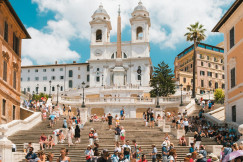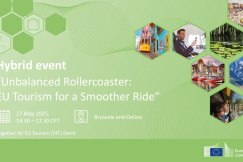Articles
09 May 2025
When Too Much Becomes Harmful: Rethinking Unbalanced Tourism in Europe
Articles
09 May 2025
Adventure tourism
Coastal, maritime and inland water tourism
Cultural tourism
+65 more
Login / create an account to be able to react
-
179

This article explores the findings of a 2022 European Commission study on unbalanced tourism growth, highlighting how overcrowding in top destinations harms residents and sustainability. It calls for smarter, more locally adapted strategies to redistribute tourism and preserve Europe's cultural and environmental heritage.
Topics
Albania
Armenia
Austria
Belgium
Bosnia and Herzegovina
Bulgaria
Croatia
Cyprus
Czechia
Denmark
Estonia
EU-27
Finland
France
Georgia
Germany
Greece
Hungary
Iceland
Ireland
Italy
Kosovo
Latvia
Liechtenstein
Lithuania
Luxembourg
Malta
Moldova
Montenegro
Netherlands
North Macedonia
Norway
Poland
Portugal
Romania
Serbia
Slovakia
Slovenia
Spain
Sweden
Switzerland
Türkiye
Ukraine
Academic / Research and VET Institutions
Business Support Organisation
Company with 250 or more employees
Cluster Organisations
Consumer Organisations
Cultural and Heritage Organisations
Destination Management & Marketing Organisations
EU Institutions
Financial Institutions and Investors
Industry Associations and Chambers of Commerce
International Organisations
Local Authorities
Media / Journalist Organisations
National authorities
Networks and Federations / Confederations
NGOs / Non-profits
Notified Bodies
Regional Authorities
SMEs (a company with less than 250 employees)
Social Economy Entity
Trade Unions
Other
-
Specific types of tourism
-
-
Adventure tourism
-
Coastal, maritime and inland water tourism
-
Cultural tourism
-
Ecotourism
-
Education tourism
-
Festival tourism
-
Gastronomy tourism
-
Health and medical tourism
-
MICE tourism
-
Mountain tourism
-
Religious tourism
-
Rural tourism
-
Sports tourism
-
Urban/city tourism
-
Wellness tourism
-
-
Transition Pathway Strategic Areas
-
-
Accessible tourism services
-
Best practices, peer learning and networking
-
Changes in tourism demand and opportunities
-
Circularity of tourism services
-
Coordinated information on travelling
-
Cross-border travelling
-
Digitalisation of tourism SMEs and destinations
-
Equal and fair tourism jobs
-
Funding and support measures
-
Governance of tourism destinations
-
Green Transition of Tourism Companies and SMEs
-
Improving formal education
-
Improving statistics and indicators
-
Innovative tourism services
-
Multimodal travelling
-
Online visibility of tourism offer
-
Pact for skills
-
Promoting PEF/OEF methods for tourism
-
R&I on climate-friendly tourism
-
R&I on digital tools for tourism
-
Short-term rentals
-
Skills needs for twin transition
-
Sustainable mobility
-
Tools for data on tourism
-
Tourism strategies
-
Training opportunities
-
Well-being of residents
-
-
Business activities
-
-
Activities of amusement parks and theme parks
-
Activities of associations and other organisations supporting tourism
-
Air passenger transport
-
Camping grounds, recreational vehicle parks and trailer parks
-
Events catering and other food services
-
Festivals, cultural and entertainment activities
-
Gardens and nature reserves activities
-
Holiday Housing / Apartments and other short stay accommodation
-
Hotel and similar accommodation
-
Mobile beverage services
-
Mobile food services
-
Museums
-
Operation of historical sites
-
Other
-
Other accommodation
-
Other amusement and recreation activities
-
Other food and beverage services
-
Other holiday reservation services
-
Other tourism transportation activities
-
Rail Passenger transport
-
Recreational and sport activities
-
Restaurants, cafes and bars (Food and Beverage serving activities)
-
Road passenger transport
-
Tour operator activities
-
Travel agency activities
-
Water (sea, coastal and inland) passenger transport
-
Share
The European tourism sector, a cornerstone of many national economies, is facing a paradox: its success is becoming its greatest threat. The 2022 Study on Unbalanced Tourism Growth at Destination Level, commissioned by the European Commission, sheds light on the growing phenomenon of overtourism - or, more precisely, “unbalanced tourism growth” – which threatens both the sustainability and competitiveness of Europe’s most iconic destinations.
According to the study, the post-COVID rebound of tourism has reignited crowding issues in cities, heritage sites, and coastal areas. While economic recovery is welcome, destinations like Barcelona, Venice, and Amsterdam are again confronting the social tensions, environmental degradation, and cultural erosion linked to excessive visitor volumes. The report stresses that unbalanced tourism is not just a matter of numbers, but of distribution. Peaks in visitor flows, seasonal pressure, and spatial concentration all contribute to the problem - and the damage is often felt most deeply by residents and local ecosystems.
One key finding is that there is no single definition or metric for unbalanced tourism. Relying solely on tourist-to-resident ratios or overnight stays misses the nuanced impact on communities. Instead, the study proposes combining quantitative data (visitor flows, occupancy rates) with qualitative insights (resident sentiment, social media feedback, environmental stress indicators) to monitor tourism intensity effectively. Importantly, the study moves beyond analysis to offer solutions.
Best practices gathered from across the EU highlight the value of tailored, destination-specific strategies. These include regulating visitor numbers through timed ticketing, promoting alternative sites to disperse crowds, creating off-season travel incentives, and investing in digital monitoring tools. Governance matters too - involving residents, businesses, and policymakers in co-creating tourism strategies increases acceptance and resilience.
What emerges clearly is that tourism management must shift from passive accommodation of growth to active shaping of flows. The goal is not to limit tourism altogether, but to steer it towards models that respect local life, protect cultural and natural heritage, and distribute benefits more fairly. In that sense, the report is a wake-up call: for destinations to remain desirable, they must first become liveable.
Comments (0)
Related content
See also
Unbalanced Tourism Growth in Europe: Understanding Pressures, Impacts and Sustainable Pathways
- Categories
- Coastal, maritime and inland water tourism Cultural tourism Ecotourism +64 more
Webinar resources "Connecting Europe: Multimodal Travel for Sustainable Tourism"
- Categories
- Coastal, maritime and inland water tourism Cultural tourism Ecotourism +64 more
Hybrid event “Unbalanced Rollercoaster: EU Tourism for a Smoother Ride”
Hybrid event | Brussels, Belgium and Online
- Categories
- Coastal, maritime and inland water tourism Cultural tourism Ecotourism +64 more




